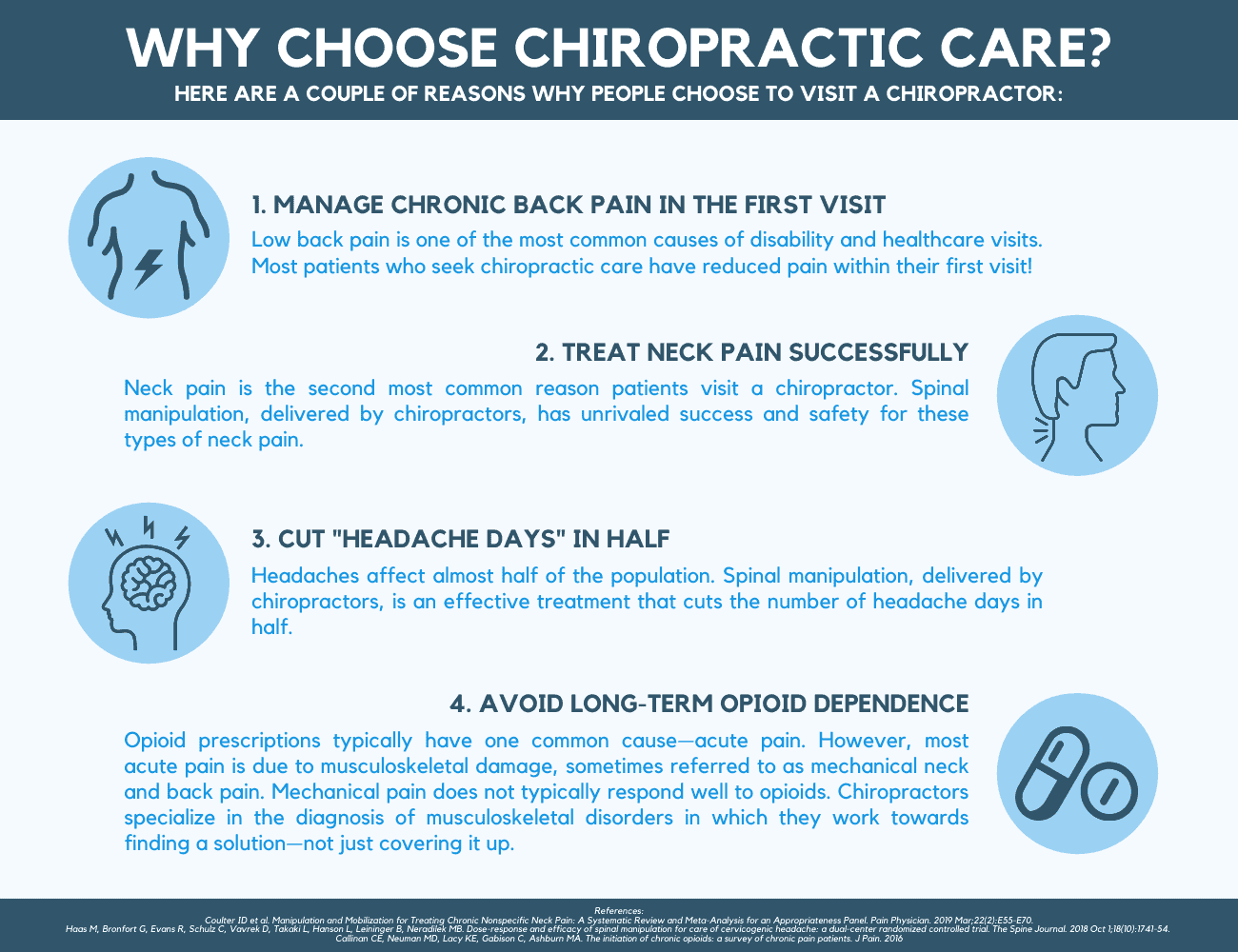Chiropractic: 5 Reasons Why It Is The Undeniable Best Choice
Chiropractic is a profession, not a treatment.
As a profession, chiropractors are trained healthcare professionals with unique expertise in managing several common health conditions. Many chiropractors utilize procedures, including joint manipulation, therapy modalities, patient education, nutrition, and rehabilitation exercises, to address each patient's unique presentation.
As chronic pain continues to rise within the US healthcare system, chiropractors utilize proven methods to reduce pain and disability without medications and surgery.
Here are five reasons people may choose to visit a chiropractor:
1. Persistent Pain
A chiropractor will spend time with you to understand your unique presentation. They will ask questions, perform a physical exam, and order any necessary tests to assess your condition thoroughly. Your pain is multi-dimensional, affecting many areas of your life—and so should your treatment plan. A chiropractor can carefully craft a care plan to attack all of the postures, activities, hobbies, and underlying stressors that may be causing your chronic pain.
2. Chronic back pain
Most people associate chiropractors with low back pain (LBP)- and rightly so. LBP plagues our society as one of the most common causes of disability and healthcare expenditures. Joint dysfunction in the lower back is a primary risk factor for the development & progression of low back degeneration. (1) Fortunately, chiropractors provide research-backed treatment with spinal manipulation, exercise, and specific patient education. Many patients have reduced pain within their first visit.
3. Nagging Neck Pain
Neck pain is the second most common reason patients visit a chiropractor. Changes to daily habits, postural stresses, and workstation ergonomics are among the most common triggers for a stiff or painful neck. If neck stiffness is left untreated, a person may experience restricted joints and less range of motion. Spinal manipulation, delivered by chiropractors, has unrivaled success and safety for these types of neck pain. (2) Manipulation, in conjunction with exercise and postural reeducation, often alleviates symptoms quickly.
4. Headaches
Headaches affect almost half of the population. 15-25% of all headaches originate from the cervical spine. (reference) The successful management of headaches requires a multifaceted approach with spinal manipulation as a cornerstone of treatment. Several studies have demonstrated the effectiveness of spinal manipulation for these types of headaches. (3-5) A recent study in The Spine Journal found that spinal manipulation cuts the number of symptomatic headache days in half, and the number of treatments has a linear dose-response to improvement. (4) Chiropractors can quickly identify the type of headache and the most appropriate treatment strategy.
5. Avoid Long-Term Opioid Dependence
Opioid prescriptions typically have one common cause—acute pain. However, most acute pain is due to musculoskeletal damage, sometimes referred to as mechanical neck and back pain. Mechanical pain does not typically respond well to a chemical solution (opioids). This ineffective treatment leads to diminished outcomes and chronic use. Opioid dependence, tolerance, and addiction often commence following an acute problem such as dental procedure, surgery, or injury. More than 25% of chronic use follows post-operative or injury-related pain. (6).
Here is how chiropractors are helping with the opioid epidemic:
Chiropractors specialize in the diagnosis of musculoskeletal disorders: their primary responsibility to the patient is to fully diagnose them.
Chiropractor'’ unique training allows them to find what is causing the pain and work towards finding a solution—not just covering up the symptoms.
Chiropractors select the right treatment, for the right patient, at the right time to resolve problems quickly.
As a profession, chiropractors are an integrated part of the solution to the opioid epidemic.
Our mission at ChiroUp is to make chiropractic care the undeniable best choice for our patients. We rally behind this profession, and we rally behind YOU on a foundation of evidence-based research.
We are proud of our wolfpack of subscribers (around the world) who are committed to providing the best possible care to their community.
To learn more about the resources we provide to help make this mission possible, you can visit our website or reach out to me personally: brandon@chiroup.com.
-
Roos EM, Herzog W, Block JA, Bennell KL. Muscle weakness, afferent sensory dysfunction and exercise in knee osteoarthritis. Nature Reviews Rheumatology. 2011 Jan;7(1):57.
Coulter ID et al. Manipulation and Mobilization for Treating Chronic Nonspecific Neck Pain: A Systematic Review and Meta-Analysis for an Appropriateness Panel. Pain Physician. 2019 Mar;22(2):E55-E70.
Malo-Urriés M, Tricás-Moreno JM, Estébanez-de-Miguel E, Hidalgo-García C, Carrasco-Uribarren A, Cabanillas-Barea S. Immediate Effects of Upper Cervical Translatoric Mobilization on Cervical Mobility and Pressure Pain Threshold in Patients With Cervicogenic Headache: A Randomized Controlled Trial. Journal of manipulative and physiological therapeutics. 2017 Nov 1;40(9):649-58.
Haas M, Bronfort G, Evans R, Schulz C, Vavrek D, Takaki L, Hanson L, Leininger B, Neradilek MB. Dose-response and efficacy of spinal manipulation for care of cervicogenic headache: a dual-center randomized controlled trial. The Spine Journal. 2018 Oct 1;18(10):1741-54.
Malo-Urriés M, Tricás-Moreno JM, Estébanez-de-Miguel E, Hidalgo-García C, Carrasco-Uribarren A, Cabanillas-Barea S. Immediate Effects of Upper Cervical Translatoric Mobilization on Cervical Mobility and Pressure Pain Threshold in Patients With Cervicogenic Headache: A Randomized Controlled Trial. Journal of manipulative and physiological therapeutics. 2017 Nov 1;40(9):649-58.
Callinan CE, Neuman MD, Lacy KE, Gabison C, Ashburn MA. The initiation of chronic opioids: a survey of chronic pain patients. J Pain. 2016.

